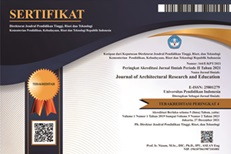Implication of Perceived Spaces Toward Visitors' Learning Motivation In Rumah Atsiri Indonesia
Abstract
Rumah Atsiri Indonesia (RAI) is an edu-recreation complex located in Tawangmangu. RAI adopts “experiencing essence” concept through a comprehensive informal learning about essential oils. RAI’s challenge as an educational leisure setting sets a lead to the main research goal: how visitors perceived spaces in RAI and related them to learning motivation. The observation areas were focused on Museum Gallery and the Essential Oils Collection Gardens. These areas provide most knowledge about essential oils to visitors. Data and information were analyzed qualitatively, by comparing physical settings characteristics of observation areas, person-centered mapping and results of informal interviews and questionnaires. As the result, this research showed that there was relation between physical setting characterictics and visitors’ learning motivation. Visitors were more motivated to learn in Essential Oils Collection Gardens, especially in outdoor garden. In this area, visitors got richer experiences because visitors had more freedom in exploring essential oil plants. As a performative space that emphasizes visitors as active participants, this area could stimulated visitors’ emotional and memories through five senses. The adventurous feeling also can be seen from some architectural factors, such as circuitous path with shortcuts, ramps and stairs, which resulting “Learning for Fun” concept. While in Museum Gallery, visitors circulation and media displays were controlled. As a narrative space that put forward the storyline about the history of essential oils, evidently, visitors got bored easily and show no interest in learning which was reflected in their withdrawal behaviors. Stimulation to visitor’s senses were also limited to sight and hearing, so visitors could not be active participant. Learning motivation was also influenced by intrapersonal factors, but these factors were not analyzed further in this research. Some architectural factors that influenced visitors’ learning motivation include: space characteristics, binding scale categories, and media display types.
Keywords: Essential Oils; Informal Learning; Physical Settings
Full Text:
PDFReferences
Ahmad, S., Abbas, M. Y., Mohd Yusof, W. Z. & Mohd.Taib, M. Z. (2015). Adapting Museum Visitors as Participants Benefits their Learning Experience? Procedia - Social and Behavioral Sciences, 168, 156 – 170.
Ahmad, S., Abbas, M. Y., Mohd Yusof, W. Z. & Mohd.Taib, M. Z. (2015). Adapting Museum Visitors as Participants Benefits their Learning Experience? Procedia - Social and Behavioral Sciences, 168, 156 – 170.
Allan, M. & Altal, Y. (2016). Museums And Tourism: Visitors Motivations And Emotional Involvement. Mediterranean Archaeology and Archaeometry, 16(3), 43-50.
De Backer, F., et al. (2015). Adult Visitors In Museum Learning Environments. Procedia - Social and Behavioral Sciences, 191, 152 – 162.
Djilani, A. & Dicko, A. (2012). The Therapeutic Benefits of Essential Oils, Nutrition, Well-Being and Health. (J. Bouayed, Ed.) Croatia: InTech.
Forrest, R. (2014). Design Factors in the Museum Visitor Experience. Queensland: Business School (Tourism Cluster) The University of Queensland.
Hamid, A.A., Aiyelaagbe, O.O. & Usman, L.A. (2011). Essential Oils: Its Medicinal and Pharmacological Uses. International Journal of Current Research, 3(2), 86-98.
Hashim, A.F., Mohd Taib, M. Z. & Alias A. (2014). The Integration of Interactive Display Method and Heritage Exhibition at Museum. Procedia - Social and Behavioral Sciences, 153, 308 – 316.
Marcillia, S. R. & Kesumasari, D. (2017). Students’ Sitting Preferences at Plaza in Educational Institution. DIMENSI − Journal of Architecture and Built Environment, 44(2), 179-188.
Packer, J. & Ballantyne, R. (2002). Motivational factors and the visitor experience: A comparison of three sites. Curator, 45(3), 183-198.
Pallasmaa, J. (2012). The Eyes of the Skin: Architecture and the Senses (3 ed.). United Kingdom: John Wiley & Sons Ltd.
Prebensen, N. K., Woo, E., Chen, J. S. & Uysal, M. (2012). Motivation and Involvement as Antecedents of the Perceived Value of the Destination Experience. Journal of Travel Research, 52(2), 253– 264.
Soto-Vasquez, M.R. & Alvarado-García, P.A.A. (2017). Aromatherapy with two essential oils from Satureja genre and mindfulness meditation to reduce anxiety in humans. Journal of Traditional and Complementary Medicine, 7, 121-125.
Van Jaarsveld, K. (2010). The Effect of The Senses on The Perception of A Brand. Stellenbosch: Department of Business Management, Stellenbosch University.
DOI: https://doi.org/10.17509/jare.v1i2.22295
Refbacks
- There are currently no refbacks.
Copyright (c) 2020 Diana Kesumasari

This work is licensed under a Creative Commons Attribution-NonCommercial-ShareAlike 4.0 International License.

This work is licensed under a Creative Commons Attribution-ShareAlike 4.0 International License.








